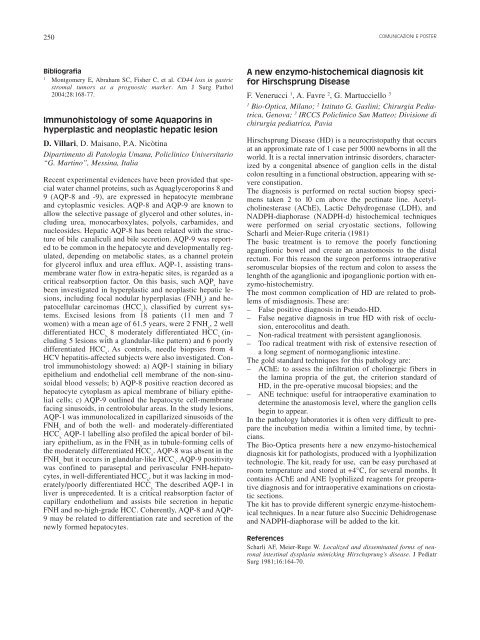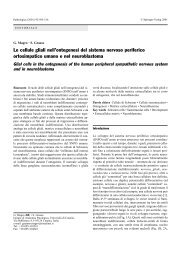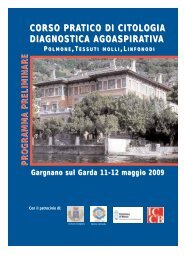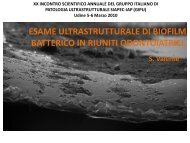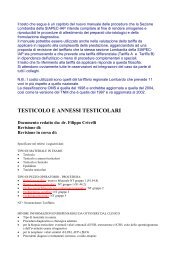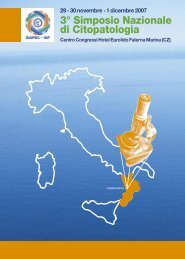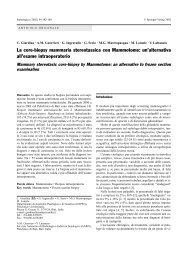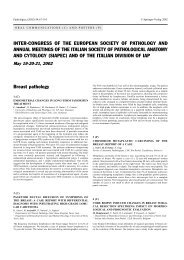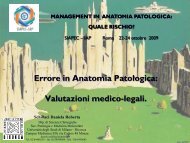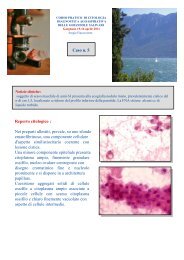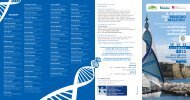pag. 216-318 - Siapec
pag. 216-318 - Siapec
pag. 216-318 - Siapec
Create successful ePaper yourself
Turn your PDF publications into a flip-book with our unique Google optimized e-Paper software.
250<br />
COMUNICAZIONI E POSTER<br />
Bibliografia<br />
1<br />
Montgomery E, Abraham SC, Fisher C, et al. CD44 loss in gastric<br />
stromal tumors as a prognostic marker. Am J Surg Pathol<br />
2004;28:168-77.<br />
Immunohistology of some Aquaporins in<br />
hyperplastic and neoplastic hepatic lesion<br />
D. Villari, D. Maisano, P.A. Nicòtina<br />
Dipartimento di Patologia Umana, Policlinico Universitario<br />
“G. Martino”, Messina, Italia<br />
Recent experimental evidences have been provided that special<br />
water channel proteins, such as Aquaglyceroporins 8 and<br />
9 (AQP-8 and -9), are expressed in hepatocyte membrane<br />
and cytoplasmic vesicles. AQP-8 and AQP-9 are known to<br />
allow the selective passage of glycerol and other solutes, including<br />
urea, monocarboxylates, polyols, carbamides, and<br />
nucleosides. Hepatic AQP-8 has been related with the structure<br />
of bile canaliculi and bile secretion. AQP-9 was reported<br />
to be common in the hepatocyte and developmentally regulated,<br />
depending on metabolic states, as a channel protein<br />
for glycerol influx and urea efflux. AQP-1, assisting transmembrane<br />
water flow in extra-hepatic sites, is regarded as a<br />
critical reabsorption factor. On this basis, such AQP s<br />
have<br />
been investigated in hyperplastic and neoplastic hepatic lesions,<br />
including focal nodular hyperplasias (FNH s<br />
) and hepatocellular<br />
carcinomas (HCC s<br />
), classified by current systems.<br />
Excised lesions from 18 patients (11 men and 7<br />
women) with a mean age of 61.5 years, were 2 FNH s<br />
, 2 well<br />
differentiated HCC s,<br />
8 moderately differentiated HCC s<br />
(including<br />
5 lesions with a glandular-like pattern) and 6 poorly<br />
differentiated HCC s<br />
. As controls, needle biopsies from 4<br />
HCV hepatitis-affected subjects were also investigated. Control<br />
immunohistology showed: a) AQP-1 staining in biliary<br />
epithelium and endothelial cell membrane of the non-sinusoidal<br />
blood vessels; b) AQP-8 positive reaction decored as<br />
hepatocyte cytoplasm as apical membrane of biliary epithelial<br />
cells; c) AQP-9 outlined the hepatocyte cell-membrane<br />
facing sinusoids, in centrolobular areas. In the study lesions,<br />
AQP-1 was immunolocalized in capillarized sinusoids of the<br />
FNH s<br />
and of both the well- and moderately-differentiated<br />
HCC s.<br />
AQP-1 labelling also profiled the apical border of biliary<br />
epithelium, as in the FNH s<br />
as in tubule-forming cells of<br />
the moderately differentiated HCC s<br />
. AQP-8 was absent in the<br />
FNH s,<br />
but it occurs in glandular-like HCC s<br />
. AQP-9 positivity<br />
was confined to paraseptal and perivascular FNH-hepatocytes,<br />
in well-differentiated HCC s<br />
, but it was lacking in moderately/poorly<br />
differentiated HCC s.<br />
The described AQP-1 in<br />
liver is unprecedented. It is a critical reabsorption factor of<br />
capillary endothelium and assists bile secretion in hepatic<br />
FNH and no-high-grade HCC. Coherently, AQP-8 and AQP-<br />
9 may be related to differentiation rate and secretion of the<br />
newly formed hepatocytes.<br />
A new enzymo-histochemical diagnosis kit<br />
for Hirschsprung Disease<br />
F. Venerucci 1 , A. Favre 2 , G. Martucciello 3<br />
1<br />
Bio-Optica, Milano; 2 Istituto G. Gaslini; Chirurgia Pediatrica,<br />
Genova; 3 IRCCS Policlinico San Matteo; Divisione di<br />
chirurgia pediatrica, Pavia<br />
Hirschsprung Disease (HD) is a neurocristopathy that occurs<br />
at an approximate rate of 1 case per 5000 newborns in all the<br />
world. It is a rectal innervation intrinsic disorders, characterized<br />
by a congenital absence of ganglion cells in the distal<br />
colon resulting in a functional obstruction, appearing with severe<br />
constipation.<br />
The diagnosis is performed on rectal suction biopsy specimens<br />
taken 2 to 10 cm above the pectinate line. Acetylcholinesterase<br />
(AChE), Lactic Dehydrogenase (LDH), and<br />
NADPH-diaphorase (NADPH-d) histochemical techniques<br />
were performed on serial cryostatic sections, following<br />
Scharli and Meier-Ruge criteria (1981)<br />
The basic treatment is to remove the poorly functioning<br />
aganglionic bowel and create an anastomosis to the distal<br />
rectum. For this reason the surgeon performs intraoperative<br />
seromuscular biopsies of the rectum and colon to assess the<br />
lenghth of the aganglionic and ipoganglionic portion with enzymo-histochemistry.<br />
The most common complication of HD are related to problems<br />
of misdiagnosis. These are:<br />
– False positive diagnosis in Pseudo-HD.<br />
– False negative diagnosis in true HD with risk of occlusion,<br />
enterocolitus and death.<br />
– Non-radical treatment with persistent aganglionosis.<br />
– Too radical treatment with risk of extensive resection of<br />
a long segment of normoganglionic intestine.<br />
The gold standard techniques for this pathology are:<br />
– AChE: to assess the infiltration of cholinergic fibers in<br />
the lamina propria of the gut, the criterion standard of<br />
HD, in the pre-operative mucosal biopsies; and the<br />
– ANE technique: useful for intraoperative examination to<br />
determine the anastomosis level, where the ganglion cells<br />
begin to appear.<br />
In the pathology laboratories it is often very difficult to prepare<br />
the incubation media within a limited time, by technicians.<br />
The Bio-Optica presents here a new enzymo-histochemical<br />
diagnosis kit for pathologists, produced with a lyophilization<br />
technologie. The kit, ready for use, can be easy purchased at<br />
room temperature and stored at +4°C, for several months. It<br />
contains AChE and ANE lyophilized reagents for preoperative<br />
diagnosis and for intraoperative examinations on criostatic<br />
sections.<br />
The kit has to provide different synergic enzyme-histochemical<br />
techniques. In a near future also Succinic Dehidrogenase<br />
and NADPH-diaphorase will be added to the kit.<br />
References<br />
Scharli AF, Meier-Ruge W. Localized and disseminated forms of neuronal<br />
intestinal dysplasia mimicking Hirschsprung’s disease. J Pediatr<br />
Surg 1981;16:164-70.


